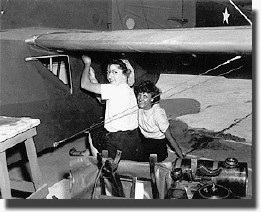Morris Field
 Morris Field was conceived in 1936 as a New Deal Works Project Administration program in Charlotte. In April 1941 the Army Air Corps identified a site on the outskirts of downtown, and over the next few months a small airstrip with two runways was constructed. Work crews composed of civilian and military personnel tore up the surrounding countryside in preparation for more buildings if the need arose. On 15 Sept. 1941 a chapel was erected for the few men stationed at the base, officially called Charlotte Airbase. The first commanding officer of the facility was Col. C. W. Howard.
Morris Field was conceived in 1936 as a New Deal Works Project Administration program in Charlotte. In April 1941 the Army Air Corps identified a site on the outskirts of downtown, and over the next few months a small airstrip with two runways was constructed. Work crews composed of civilian and military personnel tore up the surrounding countryside in preparation for more buildings if the need arose. On 15 Sept. 1941 a chapel was erected for the few men stationed at the base, officially called Charlotte Airbase. The first commanding officer of the facility was Col. C. W. Howard.
During the turbulent years of World War II, Charlotte was transformed into a military zone of men and matériel. Inside the city was a massive Quartermaster Corps Depot, and just across the border in South Carolina was a plant that made artillery shells for the navy. The attack on Pearl Harbor sparked an extension and renovation of Charlotte Airbase. In January 1942 the post was renamed Morris Field in honor of Maj. William C. Morris from Harrisburg, NC. Throughout the war the base changed as new units rotated through, becoming a repair base for flights in transit along the East Coast. This conversion led to problems such as the crash of a B-17 bomber in October 1943 costing more than $300,000 in damages. But operations at Morris Field were generally successful. Stationed there were the 29th Air Group, 40th Matériel Group, 56th Pursuit Squadron, and 62nd Pursuit Squadron. The 29th Air Group eventually went to the Pacific Theater, where many of its pilots died fighting the Japanese.
In May 1946 the Air Corps vacated Morris Field. To relieve the postwar housing shortage, Charlotte officials converted many structures that once held airplanes and brave young soldiers into apartment buildings. The city purchased the rights to the airstrip, and Morris Field became the precursor to Charlotte's Douglas International Airport. The air base where so many men trained to fight eventually became home to the North Carolina Air National Guard. In September 1998 the guard observed its 50th anniversary, dedicating a granite memorial during the ceremonies. The monument was placed close to Morris Field's original location, southwest of Charlotte, near the Charlotte Douglas International Airport.
Additional Resources:
"A History of Morris Field." The Charlotte - Mecklenburg Story. Public Library of Charlotte & Mecklenburg County. 2001. http://www.cmstory.org/homefront/places/morrisField.htm (accessed October 22, 2012).
Morrill, Dan L. "Ben Douglas." A History Of Charlotte and Mecklenburg County. Charlotte-Mecklenburg Historic Landmarks Commission. http://www.cmhpf.org/Morrill%20Book/CH10.htm (accessed October 22, 2012).
Image Credits:
"Female workers repair a plane at Morris Field during WWII." Image from the Carolinas Historic Aviation Commission / Charlotte-Mecklenburg Historic Landmarks Commission. http://www.cmhpf.org/S&Rs%20Alphabetical%20Order/Surveys&rwpahangar.htm (accessed October 22, 2012).
1 January 2006 | Howard, Joshua